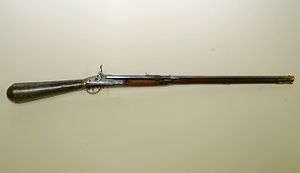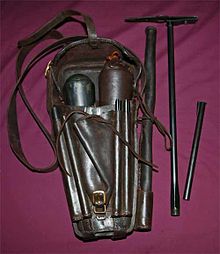Girardoni air rifle
This article has multiple issues. Please help improve it or discuss these issues on the talk page. (Learn how and when to remove these messages)
|
| Girandoni air rifle | |
|---|---|
 Girandoni system Austrian repeating air rifle, circa 1795, believed to have been taken on the Lewis and Clark Expedition | |
| Type | Air rifle |
| Place of origin | |
| Service history | |
| In service | 1780–1816 |
| Used by | Austrian Empire |
| Production history | |
| Designer | Bartolomeo Girandoni |
| Designed | 1779 or 1780 |
| No. built | 1,300 |
| Specifications | |
| Mass | 4.5 kg (9.9 lb) |
| Length | 120 cm (3.9 ft) |
| Cartridge | spherical balls |
| Caliber | .46", 11.7 mm 146.3 grains (9.48 g), or .51", 13 mm, 201.49 grains (13.06 g) |
| Muzzle velocity | about 600 fps (152 m/s), 117 ft lbs (159 J) |
| Feed system | 20/21 round magazine or hopper |
| Sights | Iron |
The Girandoni air rifle is an air gun designed by Italian inventor Bartolomeo Girandoni circa 1779. The weapon was also known as the Windbüchse ("wind rifle" in German). One of the rifle's more famous associations is its use on the Lewis and Clark Expedition to explore and map the Louisiana Purchase of 1803.
History and use
[edit]
The Lewis and Clark Expedition used the rifle in the demonstrations that they performed for nearly every Native American tribe they encountered on the expedition.[1][2] Some scholars have argued that the airgun carried by Merriwether Lewis was not a Girandoni, but a Lukens, made by Isaiah Lukens of Philadelphia.[3] However, Col. Thomas Rodney wrote the following on 8 September 1803: "Visited Captain Lewess [sic] barge. He shewed us his air gun which fired 22 times at one charge."[4] All Lukens's known airguns were single-shot muzzleloaders, not repeaters, making it very likely that Lewis's gun was a Girandoni, the only repeating airgun of the time. Lewis stated in his journals that he purchased the airgun, but it is not known when or where he did so.[5] Lewis fired the airgun at least 16 times to demonstrate it to various Native American tribes. On 24 January 1806, Lewis wrote "My air gun also astonishes them very much, they cannot comprehend it's shooting so often and without powder; and think that it is great medicine."[6][7]
Design and capabilities
[edit]The rifle was four feet (1.2 m) long and weighed ten pounds (4.5 kg), about the same size and weight as infantry muskets of the time. It fired a .46 or .51 caliber ball and had a tubular, spring-fed magazine with a capacity of 20 balls.[8][9][10] Some of the weapons were also made using a gravity-fed magazine. Unlike its contemporary, muzzle-loading muskets, which required the rifleman to stand up to reload with powder and ball, the shooter could reload a ball from the magazine by pulling a transverse chamber bar out of the breech which allowed a ball to be supplied to it and which then rebounded back to its original position with the aid of a spring, all while lying down.[8]
Contemporary regulations of 1788 required that each rifleman be equipped with the rifle, three compressed air reservoirs (two spare and one attached to the rifle), cleaning stick, hand pump, lead ladle and 100 lead balls, 1 in the chamber, 19 in the magazine built into the rifle and the remaining 80 in four tin tubes. Equipment not carried attached to the rifle was held in a special leather knapsack. It was also necessary to keep the leather gaskets of the reservoir moist to maintain a good seal and prevent leakage.[11]
The air reservoir was in the club-shaped stock. With a full air reservoir, the Girardoni air rifle had the capacity to shoot 30 shots at useful pressure. These balls were effective to approximately 125 yd (114 m) on a full air reservoir. The power declined as the air reservoir was emptied.[12]
See also
[edit]- Kunitomo air gun – type of Air rifle
- Weaponry of the Austro-Hungarian Empire
References
[edit]- ^ Wier, S.K. (2005). "The firearms of the Lewis and Clark Expedition" (PDF). p. 12. Retrieved 12 March 2013.
- ^ Girardoni air rifle as used by Lewis and Clark. A National Firearms Museum Treasure Gun. at YouTube
- ^ Garry, Jim. Weapons of the Lewis and Clark Expedition. Norman, Oklahoma: The Arthur H. Clark Co., 2012. p. 96-99.
- ^ Rodney,Thomas. A Journey Through the West: Thomas Rodney's 1803 Journal from Delaware to the Mississippi Territory, ed. Dwight L. Smith and Ray Swick. Athens, Ohio: Ohio University Press, 1997. p. 50.
- ^ Garry, Jim. Weapons of the Lewis and Clark Expedition. Norman, Oklahoma: The Arthur H. Clark Co., 2012. p. 99, 101.
- ^ Moulton, Gary. The Jpurnals of the Lewis and Clark Expedition. 13 Vols. Lincoln, Nebraska: University of Nebraska Press. Vol. 6, p. 233.
- ^ Garry, Jim. Weapons of the Lewis and Clark Expedition. Norman, Oklahoma: The Arthur H. Clark Co., 2012. p. 103.
- ^ a b Prenderghast, Gerald (4 April 2018). Repeating and Multi-Fire Weapons: A History from the Zhuge Crossbow Through the AK-47. ISBN 9781476631103.
- ^ The Beeman article on Girardoni air rifles in the sources section and an article in the German gun magazine Visier (issue 1/2007, page 141) claim the caliber was actually .463" (11.75 mm).
- ^ Die Entwicklung der Handfeuerwaffen im österreichischen Heere, 1896, Anton Dolleczek
- ^ A letter detailing regulations, "Signed, Vienna, 24th January 1788"; reproduced in Baker, G; Currie, C. The Austrian Army Repeating Air Rifle 2nd Ed., 2007.
- ^ Military writer August Haller claimed in an 1891 treatise Die österreichische Militär-Repetier-Windbüchse that the first ten shots would be effective to about 150 paces, the next ten shots up to 120–125 paces, the next ten out to 100 paces, and then the remaining air pressure in the reservoir would be too low.
External links
[edit]- Beeman's History on Austrian Large Bore Airguns
- I Benemeriti Di Cortina D’Ampezzo
- [1] (original 1780 example)
- Girardoni air rifle as used by Lewis and Clark. A National Firearms Museum Treasure Gun.
 Media related to Girandoni air rifle at Wikimedia Commons
Media related to Girandoni air rifle at Wikimedia Commons
